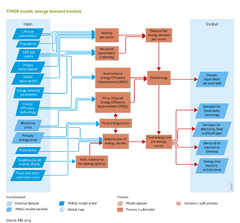Energy demand: Difference between revisions
Jump to navigation
Jump to search
m (Text replace - "Scenario drivers" to "Drivers") |
No edit summary |
||
| Line 11: | Line 11: | ||
In the TIMER energy demand module, final energy demand is simulated as a function of changes in population, economic activity and energy intensity (see flowchart). Five economic sectors are considered: industry; transport; residential; public and private services; and other sectors mainly agriculture. In each sector, final energy use is driven by the demand for energy services, such as motor drive, mass displacement, chemical conversions, lighting, heating and cooling. Energy demand is considered as a function of three groups of parameters and processes: | In the TIMER energy demand module, final energy demand is simulated as a function of changes in population, economic activity and energy intensity (see flowchart). Five economic sectors are considered: industry; transport; residential; public and private services; and other sectors mainly agriculture. In each sector, final energy use is driven by the demand for energy services, such as motor drive, mass displacement, chemical conversions, lighting, heating and cooling. Energy demand is considered as a function of three groups of parameters and processes: | ||
*activity data, for example on population and income, and more explicit activity indicators, such as steel production; | *activity data, for example on population and income, and more explicit activity indicators, such as steel production; | ||
*long-term trends that determine the intensity of use, for example, economic structural change ( | *long-term trends that determine the intensity of use, for example, economic structural change ({{abbrTemplate|SC}}), autonomous energy efficiency improvement ({{abbrTemplate|AEEI}}) and price-induced energy efficiency improvement ({{abbrTemplate|PIEEI}}); | ||
*price-based fuel substitution ( the choice of energy carrier on the basis of its relative costs). | *price-based fuel substitution ( the choice of energy carrier on the basis of its relative costs). | ||
These factors are implemented in different ways in the various sectors. In some sectors, a detailed end-use service-oriented modelling approach is used while in other sectors, the description is more generic and aggregate. Energy prices link the demand module with other parts of the energy model, as they respond dynamically to changes in demand, supply and conversion. | These factors are implemented in different ways in the various sectors. In some sectors, a detailed end-use service-oriented modelling approach is used while in other sectors, the description is more generic and aggregate. Energy prices link the demand module with other parts of the energy model, as they respond dynamically to changes in demand, supply and conversion. | ||
Revision as of 14:57, 22 May 2014
| Component is implemented in: |
|
| Related IMAGE components |
| Projects/Applications |
| Key publications |
Key policy issues
- How will energy demand evolve particularly in emerging and medium- and low-income economies?
- What is the mix of end-use energy carriers to meet future energy demand?
- How can energy efficiency contribute to reducing the growth rate of energy demand and mitigate pressures on the global environment?
